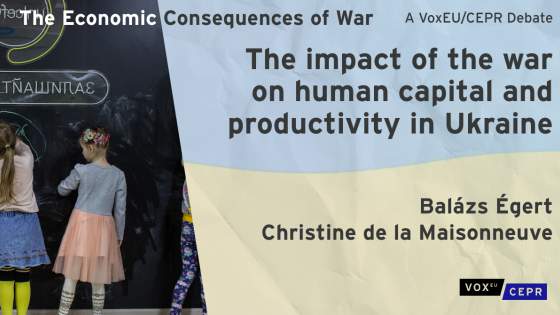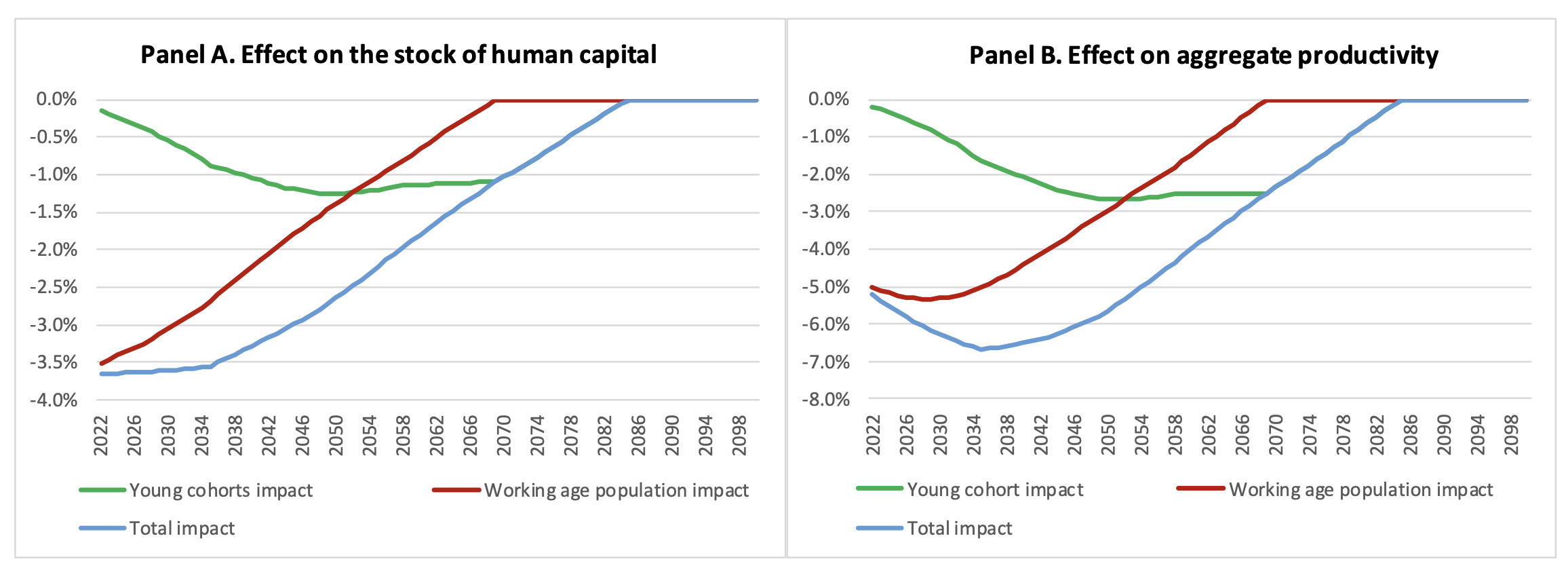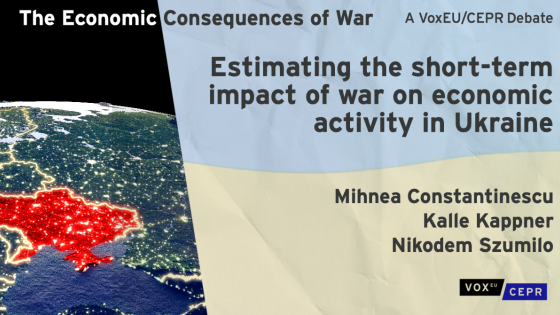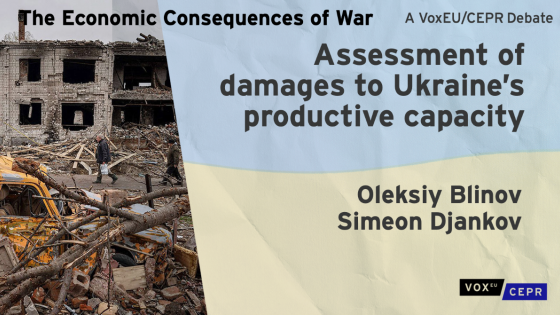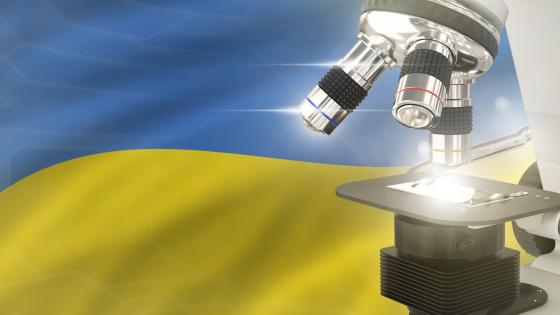In addition to the humanitarian crisis, the Russian invasion has hit Ukraine’s economy hard, with GDP plummeting and unemployment surging dramatically (Kappner et al. 2022, Kyiv Independent 2022, National Bank of Ukraine 2022, Ministry of Economy of Ukraine 2023). Rebuilding damaged and destroyed physical infrastructures is estimated to reach 130% to 330% of Ukraine’s pre-Covid GDP (Becker et al. 2022). It may take even longer and prove more difficult to offset the negative consequences of the war on Ukraine’s human capital. Against this background, this column quantifies losses in Ukraine’s stock of human capital and the subsequent adverse long-term effects on productivity and output, arising from i.) lower educational outcomes (measured by student test scores), mainly due to learning and teaching disruption, school closures, the destruction of school building, displaced students and interruptions in electricity and internet services, and ii.) skill losses and reduced working abilities of the working age population. Results suggest that total factor productivity, driven by reduced human capital, will fall by about 7% by 2035 and that the negative effects will fade away only slowly over the following decades.
The quantity and quality of education, adult skills, and productivity
Underlying the quantification of human capital losses is the stock measure of human capital developed in Égert et al. (2022) that combines student test scores, representing the quality of education, and mean years of schooling, capturing the quantity of education. The stock measure of human capital is based on the idea that adult test scores (PIAAC) can be used to calculate a cohort weighted stock measure of human capital. However, PIAAC covers a limited number of countries and has only one observation in time per country. To increase country and time coverage, a pooled regression of adult test scores on mean years of schooling and cohort PISA student test scores at age 15, is used to extrapolate adult test scores for countries, years, and cohorts missing PIAAC data. Subsequently, the stock of human capital is calculated as the cohort-weighted average of the estimated cohort-level adult test scores. This measure of human capital is then used in total factor productivity regressions, which, among other things, link human capital to productivity.
The impact of wars on learning outcomes and adult skills
Evaluating the loss in Ukraine’s human capital requires information on the war’s impact on learning outcomes and adult skills. This data is currently scarce for Ukraine, however, a small existing literature provides estimates on the impact of war on human capital formation in other contexts, namely that armed conflicts produce strong negative effects on student learning outcomes as proxied by student test scores. This is commonly thought to be the product of the deterioration of school infrastructure, a shift to military expenditures at the expense of education funding, lower educational investment by households following reductions in income and wealth and the psychological impact of conflict on children (Bruck et al. 2019, Ortiz-Correa 2014, Jurges et al., 2022). For instance, the Israeli-Palestinian conflict is estimated to have generated a decrease in student test scores of up to one standard deviation, when compared to students unaffected by the conflict. Likewise, in Colombia, researchers identified a negative impact on student test scores of up to 0.75 standard deviations for children affected by conflict. The effect is higher for young children affected by the conflict at birth than for those affected by the conflict the year they were tested (Ortiz-Correa 2014, Rodriguez and Sanchez 2010)
An additional channel via which armed conflicts erode human capital is as a result of workers’ skill losses during the war. Compared to learning losses, the erosion of adult skills has a more immediate impact on the stock of human capital. Unfortunately, little empirical evidence exists on how wars reduce adult skills. However, skill losses suffered during prolonged periods of unemployment, which have for a long time been recognised in the theoretical literature, might provide some clues for such effects (Johnson and van Doorn 1976, Pissarides 1992).
Direct evidence, is provided in Edin and Gustavsson (2008), who showed empirically that adult literacy scores of Swedish workers were affected negatively and proportionately by the duration of unemployment spells.
Beyond the general erosion of skills, skill losses might come from composition effects as better-educated people, particularly women (with children), are more likely to leave the country, sometimes for good. The composition effect will also be at play if younger people are being killed in the conflict whilst also being more skilled than older generations. A further complication is that skills required in a post-war economy might be different (Gorodnichenko et al. 2022). Finally, those fleeing the conflict might return to country with some new skills, foreign languages learned and new networks, offsetting some of the negative effects.
Evaluating the impact of the war on learning outcomes and adult skills in Ukraine
Simulation results
suggests that the overall macroeconomic effect is sizeable, dominated first by the immediate negative impact on the adult population, but then prolonged over time through the adverse effects on the student population, gradually entering the labour force in the future. For Ukraine, losses in human capital are estimated to peak between now and 2035 at around 3.6% (0.9% due to learning losses and 2.7% due to skill losses of workers). The effect will last around 35 years and will diminish until the last cohort affected retires from the labour force at the age of 65 in 2085 (Figure 1, panel A). The impact of the war on productivity is assessed on the basis of the regressions linking human capital to TFP, controlling for other determinants. Accordingly, the losses in human capital are estimated to reduce the level of productivity by 6.7% at the peak in 2035 (Figure 1, panel B).
Figure 1 The adverse effect of a two-year war on human capital and productivity in Ukraine
Source: Égert and de la Maisonneuve (2023).
The estimated long-term impact of the war in Ukraine on productivity through the human capital channel are very likely to be lower bound estimates for four main reasons (although their exact quantification would involve a lot of speculation).
First, the calibration of lower student test scores is based on armed conflicts mostly localised in nature, which might underestimate the deeper scars of a full-scale war fought in Ukraine following from the destruction of a large amount of physical educational infrastructure, the fall in the number of qualified and well-trained teachers, and the losses in students’ learning abilities in a broader sense. It is true, however, that it may be possible to mitigate some of these effects by reverting to online learning.
Second, our estimates on learning losses concentrate on students in primary and secondary schools and exclude direct losses in tertiary education.
Third, the war also generates high physical and psychological health impacts on the whole population that will leave scars for years. War trauma can have long lasting consequences on children’ mental and physical health (Bürgin et al. 2022 and Kadir et al. 2019). However, those impacts are very difficult to quantify as they differ across people and depend on the intensity and duration of the conflict.
Finally, the war might last longer than the two years assumed in our modelling, further amplifying the adverse effects on education. These effects can, nonetheless, be mitigated by the fact that many children at school age left Ukraine and that European and non-European host countries have been providing access to public education to Ukrainian children, including teaching the host country’s language.
Authors’ note: The views expressed in this column are those of the authors and do not necessarily represent the views of the OECD.
References
Becker T, B Eichengreen, Y Gorodnichenko, S Guriev, S Johnson, T Mylovanonv, K Rogoff and B Weder di Mauro (2022), “A Blueprint for the Reconstruction of Ukraine”,VoxEU.org, 7 April.
Brück T, M Di Maio and S Miaari (2019), “Learning the hard way: The effect of violent conflict on student academic achievement”, Journal of the European Economic Association 17(5): 1502-1537.
Bürgin, D, D Anagnostopoulos, B Vitiello,T Sukale, M Schmid, JM Fegert (2022), “Impact of war and forced displacement on children’s mental health—multilevel, needs-oriented, and trauma-informed approaches”, European Child & Adolescent Psychiatry 31(3): 845-853.
Dinerstein M, R Megalokonomou and C Yannelis (2020), “Human Capital Depreciation”, CESifo Working Paper No. 8614.
Edin P-A and M Gustavsson (2008), “Time Out of Work and Skill Depreciation”, Industrial and Labor Relations Review 61(2): 163-180.
Égert, B, C de la Maisonneuve and D Turner (2022), “A new macroeconomic measure of human capital exploiting PISA and PIAAC: Linking education policies to productivity”, OECD Economics Department Working Papers, No. 1709.
Égert, B, and C de la Maisonneuve (2023), “The impact of the war in human capital and productivity in Ukraine”, CESifo Working Paper No.10513.
Gorodnichenko Y, M Kudlyak and A Şahin (2022), “The Effect of the War on Human Capital in Ukraine and the Path for Rebuilding”, IZA Policy Paper No. 185.
Johnson P S and J van Doorn (1976), “Skill Loss and Unemployment: A Note”, British Journal of Industrial Relations 14(2): 202-205.
Jürges H, S Luca, H Sameh and A Schwarz (2022), “Cohort at risk: long-term consequences of conflict for child school achievement”, Journal of Population Economics 35: 1-43.
Kadir A, S Shenoda and J Goldhagen (2019), “Effects of armed conflict on child health and development: A systematic review”, PloS ONE 14(1): 1-37.
Kappner, K, N Szumilo and M Constantinescu (2022), “Estimating the short-term impact of war on economic activity in Ukraine”, VoxEU.org, 21 June.
Kyiv Independent (2022), “Ukraine’s unemployment rate record high amid war, but labor market recovering in some regions”, 21 August.
Ministry of Economy of Ukraine (2023), "The Ministry of Economy preliminarily estimates the fall in GDP in 2022 at the level of 30.4%", 5 January.
National Bank of Ukraine (2022), Inflation Report, July 2022.
Ortiz-Correa J S (2014), “Math and Language at War: The Effect of the Colombian Armed Conflict on Math and Language Learning”, International Journal of Developing and Emerging Economics 2(3): 1-30.
Ortego-Marti, V (2017), "Differences in skill loss during unemployment across industries and occupations," Economics Letters 161(C): 31-33.
Pissarides C A (1992), “Loss of Skill During Unemployment and the Persistence of Employment Shocks”, Quarterly Journal of Economics 107(4): 1371-1391.
Rodriguez C and F Sanchez (2010), “Books and Guns: The Quality of Schools in Conflict Zones”, Universidad de los Andes-Facultad de Economía. Documentos CEDE, 2010-38.
